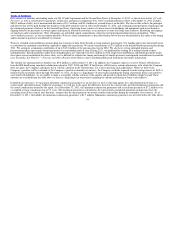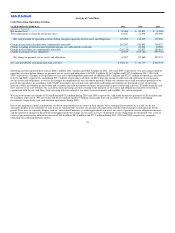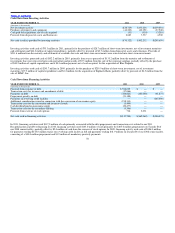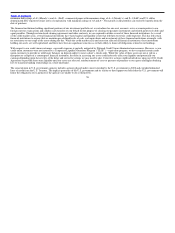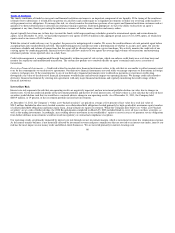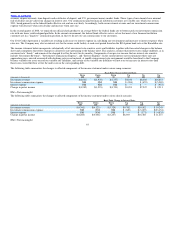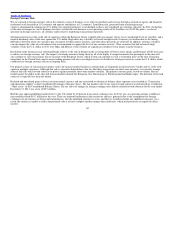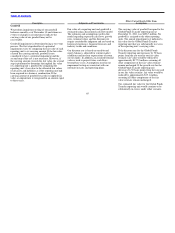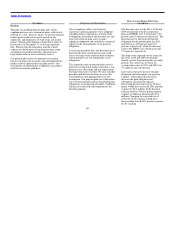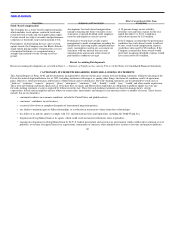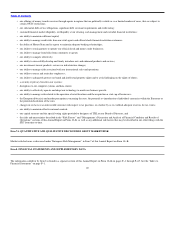MoneyGram 2011 Annual Report Download - page 61
Download and view the complete annual report
Please find page 61 of the 2011 MoneyGram annual report below. You can navigate through the pages in the report by either clicking on the pages listed below, or by using the keyword search tool below to find specific information within the annual report.
Table of Contents
The timely remittance of funds by our agents and financial institution customers is an important component of our liquidity. If the timing of the remittance
of funds were to deteriorate, it would alter our pattern of cash flows and could require us to liquidate investments or utilize our revolving credit facility to
settle payment service obligations. To manage this risk, we closely monitor the remittance patterns of our agents and financial institution customers and act
quickly if we detect deterioration or alteration in remittance timing or patterns. If deemed appropriate, we have the ability to deactivate an agent’s
equipment at any time, thereby preventing the initiation or issuance of further money transfers and money orders.
Agents typically have from one to three days to remit the funds, with longer remittance schedules granted to international agents and certain domestic
agents. As of December 31, 2011, we had credit exposure to our agents of $352.0 million in the aggregate spread across over 12,000 agents, of which four
agents owed us in excess of $15.0 million.
While the extent of credit risk may vary by product, the process for mitigating risk is similar. We assess the creditworthiness of each potential agent before
accepting them into our distribution network. This underwriting process includes not only a determination of whether to accept a new agent, but also the
remittance schedule and volume of transactions that the agent will be allowed to perform in a given timeframe. We actively monitor the credit risk of our
existing agents by conducting periodic financial reviews and cash flow analyses of our agents that average high volumes of transactions and monitoring
remittance patterns versus reported sales on a daily basis.
Credit risk management is complimented through functionality within our point of sale system, which can enforce credit limits on a real−time basis and
monitor for suspicious and unauthorized transactions. The system also permits us to remotely disable an agent’s terminals and cause a cessation of
transactions.
Derivative Financial Instruments — Credit risk related to our derivative financial instruments relates to the risk that we are unable to collect amounts owed
to us by the counterparties to our derivative agreements. Our derivative financial instruments are used solely to manage exposures to fluctuations in foreign
currency exchange rates. If the counterparties to any of our derivative financial instruments were to default on payments or experience credit rating
downgrades, the value of the derivative financial instruments would decline and adversely impact our operating income. We manage credit risk related to
derivative financial instruments by entering into agreements with only major financial institutions and regularly monitoring the credit ratings of these
financial institutions.
Interest Rate Risk
Interest rate risk represents the risk that our operating results are negatively impacted, and our investment portfolio declines in value, due to changes in
interest rates. Given the credit risk profile of the investment portfolio and the low level of interest rates, we believe there is a low risk that the value of these
securities would decline such that we would have a material adverse change in our operating results. As of December 31, 2011, the Company held
$600.9 million, or 19 percent, of the investment portfolio in fixed rate investments.
At December 31, 2011, the Company’s “Other asset−backed securities” are priced on average at five percent of face value for a total fair value of
$24.2 million. Included in other asset−backed securities are collateralized debt obligations backed primarily by high−grade debt, mezzanine equity tranches
of collateralized debt obligations and home equity loans, along with private equity investments. While the Company does believe its “Other asset−backed
securities” are at a risk of further decline, the 2008 Recapitalization completed on March 25, 2008 included funds to cover all losses on these securities, as
well as the trading investments. Accordingly, any resulting adverse movement in our stockholders’ equity or assets in excess of payment service obligations
from further declines in investments would not result in regulatory or contractual compliance exceptions.
Our operating results are primarily impacted by interest rate risk through our net investment margin, which is investment revenue less commissions expense.
As the money transfer business is not materially affected by investment revenue and pays commissions that are not tied to an interest rate index, interest rate
risk has the most impact on our money order and official check businesses. We are invested primarily in interest−bearing cash
60






